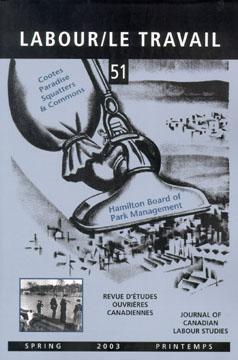Abstract
Working-class Hamiltonians responded to a local housing crisis by creating a boathouse community along the shoreline of Burlington Bay and Dundas Marsh. Leasing or simply squatting the land, they enjoyed access to good fishing and hunting, a clean place to live, and seclusion from the gaze of local police. The notorious reputation of a nearby hotel, the presence of transients in the area, and rough elements of working-class recreation, however, made the community a prime target for urban reformers. They saw it as an unsightly problem, standing in the way of their plans to create an aesthetically-pleasing, moral, and orderly city. The "war on the squatters" shows the ways in which urban planners, conservationists, and moral reformers sought to reshape the human and natural environment of the bay, often at the expense of working people. Residents who had enjoyed resource and recreational advantages of living on the margins of Hamilton society paid the price politically when reformers contested their use of the area's natural resources. Although they won limited sympathy, they did not have the economic, legal, or political resources to fight those who saw their community as an aesthetic and moral blot on Hamilton's waterfront.
Résumé
Les hamiltoniens de la classe ouvrière ont répondu à une crise du logement local en créant une communauté de remise à bateaux le long du rivage de la baie Burlington et du marais Dundas. Louer ou simplement squatter sur le terrain, ils se régalaient d'avoir accès à la pêche et à la chasse, d'avoir un endroit propre à habiter et d'être isolés du regard méprisant de la police locale. Le fait notoire d'un hôtel à proximité immédiate, la présence des gens de passage dans la région, ainsi que les éléments bruts de la création de la classe ouvrière, ont, toutefois, fait de la communauté une cible de choix pour les réformateurs urbains. Ces derniers la voyaient comme un problème esthétique, un obstacle à leurs plans de créer une ville plaisante, morale et bien rangée. La « guerre sur les squatters » indique la façon dont les planificateurs urbains, les conservationnistes, et les réformateurs moralistes ont cherché à réorganiser l'environnement humain et naturel de la baie, souvent au détriment des travailleuses et travailleurs. Les résidents qui ont bénéficié des ressources et de la récréation en vivant sur les marges de la société de Hamilton ont payé le prix politiquement quand les réformateurs ont contesté leur utilisation des ressources naturelles de la région. Bien qu'ils aient gagné un peu de sympathie, ils n'avaient pas les ressources économiques, juridiques ou politiques pour se battre contre ceux qui voyaient leur communauté comme un coin inesthétique et immoral sur les bords de l'eau à Hamilton.
